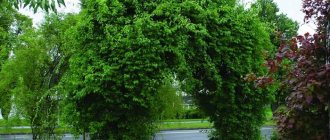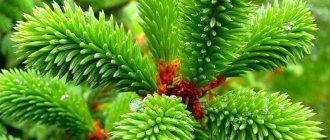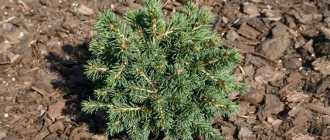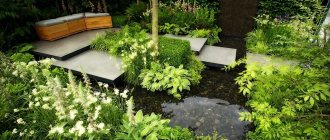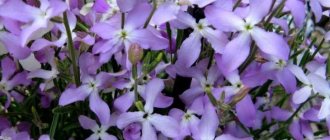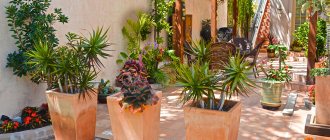When buying ornamental grasses, we often fall for their unpretentiousness, believing that there will definitely be no fuss with them. In the first summer of planting, they actively grow and develop, delighting the owners, but next spring they may not turn green.
This is due to the fact that all the inflexibility of cereals is explained by the type of soil, watering and fertilizer, but many of these herbaceous plants react extremely negatively to frost. Ornamental grasses with the most striking appearance are often natives of hot countries, and their “wintering” mechanism is simply not provided by nature.
But you shouldn’t give up growing these lush bushes with interesting colors; you just need to choose those cereals that are bred and adapted to regions with a similar climate and are characterized by increased winter hardiness.
We have already advised which ornamental grasses and grains are suitable for the northern regions; today we will talk about those representatives that will feel better in a plot in the middle zone (climate zone 5-6).
Arundo reed (giant reed)
It’s not for nothing that the second name for reed arundo is giant. The stems of this cereal with linear-lanceolate leaves can grow 4-6 m in height, and long rhizomes very actively “develop” the soil. If you decide to have this plant in your garden, remember that it is extremely aggressive and fast-growing and requires restrictions on the territory.
Arundo prefers sunny, damp places (an area near a pond is quite suitable). It blooms in autumn with thick lush panicles, requires spring pruning to a height of no more than 10 cm and shelter for the winter.
The varieties Variegata and Versicolor are most often cultivated for decorative purposes - the first has leaves with longitudinal wide white stripes, and the second has bright yellow-green leaves.
Lightning blue
Blue lightning is another tall grass with glaucous leaves and blue-violet panicles. It also needs moisture, planted together with flowers with a similar growth regime, or decorates the edges of artificial ponds.
Planting trees on the siteKerria or Keria: photo and description of the shrub, rules and subtleties of growing a plant with yellow flowers
- Ornamental shrubs in landscape design blooming in autumn
The Miscanthus family deserves special attention. These giant-sized cereals with an erect stem have many varieties that differ in color and shape. This light-loving and moisture-loving plant, with a height of 80 cm to 3 m, needs protection from frost.
Used in mixborders, for decorating ponds, luxurious bushes of Chinese and sucrose miscanthus can become an exquisite decoration of green lawns.
Veynik
Huge reed bushes can be found all over the world. Its height reaches a meter, so it is perfect for the role of a tapeworm or a vertical part in a group planting. Used in borders and hedges. In summer, the stems and spikelets of reed grass are green; by autumn they partially turn yellow, and in winter, covered with frost, they become pearly and continue to decorate the garden.
The most popular varieties of reed grass: Avalanche, Waldenbush, Karl Forster, Overdam.
Reed grass is propagated by dividing the bush, in May, every 5-7 years. If this is not done, the bush will outgrow and become disproportionate. It grows well in any soil, but if you give it a sunny and fertile area, it will become the pride of your garden in a couple of years.
What are the pros and cons
In the wild, they are excellent at preventing soil erosion. Their excellent property is excellent survivability even in an unfavorable place. Equally important is the ability to design flower beds with different heights of grass.
But there is one drawback - they tend to grow strongly. However, this can be easily stopped by physically blocking the path of the roots (using borders or buried slate) and weeding the surrounding areas. And if that doesn't suit you, consider options with artificial ornamental grass.
If you compare cereals and other types of plants, the former are an excellent choice, because There will be significantly less hassle with them. And they can delight you for up to 3-5 years in one place (the growth period depends on the type of grass).
Imperata cylindrical
Although imperata is native to the tropics, this perennial grass has adapted well to our climate zone. This moderately moisture-loving plant prefers full sun, but can also grow in partial shade. Well-drained soil is preferable for it.
The thick, dense bases of imperata quickly crowd out other vegetation in the vicinity.
Most often in gardens you can find the Imperata variety Red Baron, whose leaves at a young age are bright green with crimson-red tips, and as they grow they actively turn red along their entire length, becoming blood-red by autumn. Against the background of foliage of such a rich color, silvery fluffy spikelets look gentle.
What is suitable for garden decoration
Let's look at several types of plants that can be used to decorate garden areas:
- lawn grass – very popular due to its well-groomed appearance. It fills empty spaces and spaces between tall vegetation. But the condition of the lawn must be constantly monitored so that it does not lose its presentability;
- grasses creeping along the surface of the ground are ground cover ; they can also be used to decorate spacious areas. Such vegetation serves as a natural habitat for insects that benefit the garden, protects the soil from dryness and weathering and saturates it with useful substances;
- The brightness of the garden area can be emphasized by climbing plants and flowers ;
- It is also advisable to find an area for planting medicinal plants with healing properties on the site or in the garden, for example, echinacea - this herb is used for the treatment and prevention of many ailments;
- cereal crops are an excellent solution for those who want to demonstrate the grace of the garden and emphasize the natural beauty. Such plants look advantageous even without combination with flowers;
- tall plants are suitable for decorating the central areas of garden areas. They will turn into the main component of landscape decor and will focus attention;
- to decorate the garden area, you can also use a variety of ornamental vegetation in hydroponics: for its growth, not soil is used, but a special nutritional composition;
- The finishing touch to the design can be spicy varieties of plants with a pleasant aroma. Having such fragrant herbs in your garden will make you want to spend more time outdoors.
Medicinal herbs in the garden: photos and descriptions
Ornamental cereals, photo
Ornamental grasses for flower beds: names and photos
Recommendation: if you do not have the ability to control the growth of plants and care for them, you can choose artificial grass.
In addition to the garden area, you can also decorate the space between the trees on the site with herbs. Such a design will make the garden area more comfortable.
Feather grass
This genus of short-rhizome perennial grasses includes more than 300 species, many of which are suitable for decorative plantings on the site. Several types of feather grass are suitable for middle latitudes - feathery, thin and shiny, which differ in the timing of flowering, as well as the color and width of the foliage.
All of them are light-loving, frost- and drought-resistant, and love dry, non-acidic, well-drained soils. Feather grass is a slow-growing plant, but very durable and unpretentious, capable of turning your site into a real steppe, swaying in the wind. They reproduce by seeds and by dividing the bush; the leaves of the feather grass are cut off in the spring, and the flower stalks in the fall.
Decorative grass and design
The plant world is very complex and diverse, and therefore some of the plant groups are combined into large families.
One of them is herbs, which people include not only cultivated plants, but also ordinary weeds, which is quite normal.
However, we recommend that you look specifically at the photos of ornamental grasses. By the way, even an ordinary lawn is a grass, and an ornamental one at that, so you already understand how diverse this group of plants is.
Despite the fact that large plants, such as trees and shrubs, are much more visible on the site, and flowers stand out more in their beauty, ornamental grasses are a very powerful tool in the hands of a landscape designer.
In total, ornamental grasses can be divided into three large categories - cereals, artificial and lawn.
Each type of grass has its own role, quite important on the scale of the site and the territory that is adjacent to it, and therefore you need to learn how to use them.
Keleria (thin-legged) gray
This genus of perennial herbs with narrow-linear leaf blades grows to only 30-40 cm in height. But its dense turf with silver-blue leaves looks very elegant in the garden. Keleria blooms in June-July with cylindrical spike-shaped panicles.
Thin-legged gray looks beautiful on rocky hills and rockeries, tolerates cold winters well, but needs additional drainage and loves the sun very much. Propagated by seeds and dividing the bush, requires pruning in March-April.
Kolosnyak
It will look good as a single bush or as a border. Goes well with lilies. It is painted gray and retains its shape well. The disadvantage is its rapid growth, which can be combated by fencing the grass with slate or planting it in a container without a bottom.
Miscanthus
The green “fountains” of miscanthus are good in themselves, and during flowering, their pink or silver panicles attract all eyes. Depending on the variety, the plant can reach from 0.8 m to 2 m in height, and with age it can grow up to 2 m in diameter.
The most popular miscanthus varieties: Little Kitten, Yaku Jima, Adagio, Kleine Silberspinne (compact), Kleine Fontäne, Ferner Osten, China, Flamingo (medium), Goliath, Grosse Fontäne, Professor Richard Hansen, Rotfuchs (large).
All miscanthus love water and sun, so if you want to grow a large, lush grass, do not forget to water the plant and give it a place on the sunny side of the site. Active growth of miscanthus can become a problem for its neighbors in the flower bed, so either plant it in privacy or dig a border tape around the roots to a depth of at least 30 cm.
- Miscanthus - a grass for a garden in the Provence style
Cereals can decorate the garden no worse than beautiful flowering plants. Miscanthus is a clear confirmation of this.
Mace Bearer
The dense, seemingly bristling bushes of the gray macebearer are ideal for decorating borders 20-30 cm high. This light-loving and fast-growing ground cover plant takes root well in sandy soils of the middle zone.
- Indoor ventilation
Choosing grass for the lawn
Deutzia is blooming - summer is coming
Molinia
Until recently, this unpretentious ornamental grass was more often found in swamps than in garden plots, but now designers appreciate it. The modest plant requires minimal care only in the first two seasons, and then remains attractive for decades without your intervention.
The easiest way to grow is blue molinia, but if you want maximum splendor and bright colors, you should pay attention to reed molinia and varieties such as Bergfreund, Fontane, Staefa.
Molinia is propagated by dividing the bush, care is reduced to watering during dry periods, and it can cope with weeds on its own. Lightning wakes up late, so don’t rush to trim old leaves in the spring.
Lawn grass
Owners of personal plots who do not plan to lay out beds for the sake of obtaining vegetable crops often set aside free territory for a lawn. Its arrangement requires significant effort at the stage of planning and preparing the site. The selected area is dug up, carefully selecting weeds, stones, and foreign objects, leveled, and enriched with fertile soil.
You can create a lawn by sowing a mixture of herbs, ready-made or made yourself, or choose a rolled version. The grass mixture usually consists of grasses: meadow bluegrass, red fescue, thin bentgrass, perennial ryegrass, creating a dense, bright green covering.
Read more about site preparation, selection and planting of lawn grass in the article on our website.
An excellent option for simulating a meadow is a Moorish lawn with various combinations of cereals and flowering plants. Chamomile, clover, calendula, cornflower, bluebell, eschscholzia, flax, poppy, nemesia, toadflax and other annual and perennial flowers will create bright “sunny” spots against the background of green cereals.
The Moorish lawn delights with colors and aroma, does not require much care - the grass in its composition does not require soil fertility and regular mowing
An easy-to-use lawn roll is a turf of perennial grasses that is rolled out over the surface of the soil, like a carpet. It is grown in the field: the seeds are sown on special mats made of natural or artificial fiber.
Muhlenbergia hairy (deer grass)
Muhlenbergia is a warm-growing herbaceous perennial native to North America. In our latitudes it forms curtains from half a meter to a meter in height and width. Its leaves are needle-shaped - very narrow and hard. Dark green in summer, by autumn they acquire a bronze or copper tint and retain this color for a long time in winter. The plant blooms in August-September with very fluffy pinkish panicles, which then become purple, and even later – light brownish.
Muhlenbergia prefers slightly acidic loose soils, sunny or semi-shaded places, and is otherwise extremely unpretentious. It only does not tolerate severe frosts and requires shelter for the winter. Propagated by seeds or dividing the bush, needs spring pruning.
Ornamental grasses: a beautiful garden all year round
The fashion for cereals arose in Europe and America about 40 years ago. Landscape designers began to widely use ornamental grasses to create so-called “naturgadens”. At first these were wild “natives”, and then – garden plants imitating them.
Natur gardens are simple, easy and natural. To create one, you don’t have to have a remarkable imagination and delicate taste, because nature itself can suggest ideas. One of the advantages of such a garden is its decorative value throughout the year. Many cereals are especially beautiful in late autumn, when, after the first frosts, small silvery droplets appear on the leaves and inflorescences. And even on harsh winter days, tall plants with a snow cushion on their spikelets are pleasing to the eye.
Most cereals are unpretentious and can grow in poor soils without requiring regular watering and fertilizing. Often they only need spring pruning of shoots.
Due to their unusual appearance, cereals combine well with many plants. They can be used almost everywhere - in rock gardens, near a pond, and even in “front” flower beds. Although there is an opinion that it is better not to plant cereals next to such spectacular flowers as cannas, roses, begonias, such compositions look very harmonious and unusual.
The range of herbs from the cereal family is unusually wide. The color of the leaves is also varied - from various shades of green to yellow, brown and even dove-blue. In addition, there are variegated varieties, the green leaves of which are painted in white, yellow, cream, burgundy stripes and spots.
Perhaps the most undemanding herb is Sesleria blue . This evergreen perennial is well able to survive snowless winters and frosts down to -30 ° C. Sesleria feels good both in open sunny places and in the shade. Such a lawn will be a delight for the eyes even in “bald” winters with little snow.
reed grasses are popular in ornamental gardens . The cereal also overwinters well and tolerates heat. However, there are heat-loving species that are not recommended to be grown in Russia: Calamagrostis foliosa, Calamagrostis nutkaensis, Calamagrostis ophitidus. Caring for the plant is simple: you need to control the growth of the turf and cut off the hard above-ground part in the fall: it does not have time to rot over the winter. Reed grasses are aggressors, so when planting, the area of their growth is limited.
In dry areas of the garden, it is good to plant sandy elymus (wool grass, wheatgrass) . The narrow bluish-gray leaves of the plant reach a meter in height. Elimus is also growing rapidly, going beyond its allotted boundaries. Members of forumhouse.ru advise planting this cereal in a container without a bottom, dug into the ground.
If you don’t have the opportunity to water your garden often, another drought-resistant grass will help you out - gray fescue . The plant forms a compact bluish tussock and looks good in rockeries, next to sedums, carnations, and hostas. The cereal overwinters without shelter. Every 2-3 years, a fescue clump needs to be divided. Forum members recommend planting the plant directly in the ground, through seeds, and not seedlings (it needs a lot of light).
The turf pike (meadow pike) is also worthy of your attention . The perennial grass, up to one and a half meters high, blooms in June-July with golden-yellow spikelets. The leaves remain decorative in winter. The plant is good to plant next to astilbe and irises. The grass looks impressive against the background of shrubs, various types of mulch (gravel, bark, pine nut shells), next to broad-leaved plants. Forum member Skisa notes that the plant has a problem - by the end of the season it is affected by rust, but varietal plants are not susceptible to this:
— If you need 3-5 bushes for design, it is better to buy a variety. If you are planting a large tract, then dig it up and once a season, for prevention, treat it against rust.
Haretail, or lagurus, is an unpretentious annual grass up to 20 cm high, with inflorescences in the form of fluffy tails. The plant grows well in sunny areas, in rock gardens. This grass is often used to frame flower beds and garden beds. It looks good in front of roses and other shrubs.
Setaria (bristleweed, mice, mogar) is a tall plant (more than 1 m) with beautiful dense inflorescences with bristles similar to caterpillars. Setaria is an excellent material for dried flower arrangements. It is better to plant mice in a mixed border, on a rocky hill, near fences and outbuildings. In order for the cereal to bloom early, the seeds are sown for seedlings in April, and the seedlings must be thinned out.
Grasses such as feather grass , cortaderia , pennisetum , imperata , pampas grass (cortaderia) are very impressive, but it is better not to plant them in our climate: they are whimsical and heat-loving. Some of them can be grown in containers that are brought indoors for the winter.
Instead of pampas grass in the middle zone, a forum member ssss-xxxx advises growing a cereal that is not so demanding of heat - miscanthus . In good conditions it can grow up to 2 meters. The silvery or reddish-brown inflorescences of the plant are a wonderful addition to the garden, especially in winter. There are also variegated varieties of miscanthus, for example, “zebrina”.
You can’t talk about all the grains in one article. At your leisure, we advise you to take an interest in such spectacular herbs:
- switchgrass - up to 2 meters in height, with wide panicles of pinkish or reddish color, grows on any soil;
- Maned barley is a very beautiful, flexible cereal that goes well with other plants, with stones, driftwood, and is great in flower arrangements;
- hakonekloya - this grass will give the garden a Japanese flavor; in our climate it feels best on slopes, forest areas, and near water bodies;
- ryegrass (tall, bulbous) - a plant with white-striped leaves, reaches a meter in height, prefers sunny places, easily propagated by tubers;
- high pearl barley (Siberian) - a cereal with very beautiful silvery inflorescences; a prerequisite for cultivation is good drainage; stagnation of water is detrimental to it;
- molinia (blue, reed) - a real fountain with a height of 0.6 to 1.5 m, blooms in July-August with purple inflorescences, does not require shelter for the winter;
- viviparous sheep - a cereal with leaves with a bluish tint, grows up to 2 meters; loves sunny places, fertile, well-drained soils; recommended neighbors: asters, sedum, catnip;
- Transylvanian pearl barley - a perennial up to a meter in height with beautiful burgundy panicles;
- foxtail (alopecurus) - a plant no more than a meter high, used to create lawns in shaded areas;
- dripseed is an aromatic grass that grows in one place for decades, forms a low (up to 40 cm) tussock, the inflorescences rise to a height of 80 cm, and in the fall they acquire an orange-copper color.
Read more about grains in this topic. This video will tell you about the selection of plants for an ornamental garden. This article will advise which cereals to plant to form a lawn and which ones should not.
Sheep evergreen
Helictotrichon, evergreen oat, viviparous oat - this cereal has many names and one essence. Its bright, lush bushes can be an ideal border, fit into any flower bed or grow in a container. Frost resistance and unpretentiousness make it a real find for our climate or for novice gardeners.
The most popular varieties of sheep: Pendula, Robust, Saphirsprudel.
The main requirements of sheep are poor soil, sunlight and dryness. From excess nutrition it gets sick, in the shade it loses the blue tint of its foliage, and when it is over-watered, its roots begin to rot and the leaves become covered with rust. For maximum decorativeness, the bushes should be divided every three years.
How to grow
It is easy to get confused among the many names of ornamental grass. However, you need to know for sure whether it is suitable for your climatic conditions. They may need to be covered for the winter. After all, many species were brought from tropical and subtropical countries, where winters are much warmer than in the central zone, and even more so to the north. Usually all the required information is written on the packaging.
With proper care, the climate should not create any problems.
There are unpretentious varieties that should not be sown directly into the garden. First, this ornamental grass in pots must get stronger, and then it can be planted. Otherwise, large plants can drown it out. Some species can be planted not only from seeds, but also by dividing the roots.
Cold-resistant varieties are characterized by early growth after the snow melts. If transplantation or seating is required, it is worth carrying out these procedures in early spring or in September-October. An important condition is the air temperature is no more than +20 Celsius.
Pennisetum foxtail
This warm-growing dense-turf grass can grow up to a meter in height and up to one and a half meters in width (depending on the variety). It has narrow, hard, rough, beautifully curved bright green leaves, sometimes turning yellow in cold weather, and fluffy spikelets reminiscent of a fox's tail (hence the name).
The plant prefers sheltered from the wind, sunny or semi-shady places with well-drained soil. It is advisable to cover the pennisetum for the winter, although it is considered relatively cold-resistant. Dwarf species of this cereal are also suitable for container growing. In this case, the pot with the plant is brought indoors for the winter.
The best ornamental varieties of pennisetum foxtail: Hameln (tall, with green leaves and beige-brown spikelets, blooms in July), Little Bunny (short, with lush green leaves in summer and golden yellow leaves in autumn), Moudry (medium size, with green leaves and lilac-brown spikelets, blooms in August-September).
Perlovnik ciliated
This perennial long-rhizome grass loves sunny places and light, moist soils. It grows in dense tussocks that form narrow light green leaves. Flower stems about 60 cm high appear in late spring or early summer, forming a whole cloud of creamy-white graceful drooping panicles, for which the cereal is valued. The spikelets are decorative for a little over a month.
The plant is quite unpretentious. Pearl barley reproduces by dividing the bush or by seeds; it requires pruning in August.
Decorative millet
This is an annual that has beautiful leaves that are purple-brown in color and wide. Small shoots are green with a purple border. The grown plant looks like a reed.
An unusual inflorescence appears in mid-summer, and by August white specks of dust appear on it. Looks great until the first frost.
Bulbous ryegrass
Small striped bushes of bulbous ryegrass are loved by designers for their easy shaping and low aggressiveness. They spread much less than most grains, they can be given any shape, and after a couple of weeks after cutting to zero, they turn green again.
Caring for ryegrass is simple: it is cut three times a season, fed with diluted compost once a year and watered during dry periods. Diseases and pests do not attack him, and he copes with weeds himself.
Sesleria
Of the existing types of Sesleria, only 4 are used in landscape design - blue, autumn, shiny and black-flowered. Each of them is good in its own way, has a different size and color of leaves and inflorescences.
Growing rules for all types of Sesleria are general. It can be propagated by seeds or by dividing the bushes, which must be done every 4 years. It grows quietly in poor soils, rarely needs watering and does not require fertilizing at all. Sesleria looks brighter in the sun, but grows well in partial shade.
Spicy-flavoring herbs
The name of this group characterizes the main purpose of the plants - use as seasonings. Most of them have medicinal value, being a valuable source of vitamins, organic acids, mineral salts, and biologically active substances. Among the spicy crops there are both annuals and perennials.
Cooking is unthinkable without spices, fresh and dried; plants can also be used to decorate the garden
Annual crops: anise, basil, chervil, coriander, annual marjoram, borage, arugula, trigonella (blue fenugreek), savory.
Borage is often pulled out like a weed. In Western Europe, it is added to salads, cold soups, fish and meat dishes, and drinks; Iranians drink tea from dried flowers
Suitable perennial ornamental herbs for the garden include: hyssop, lavender, lofanthus, lovage, perennial marjoram (oregano, oregano), lemon balm, monarda, peppermint, rosemary, rue, thyme (thyme), vegetable fennel, sage, tarragon.
Perennial marjoram is an excellent honey plant, an aphrodisiac, and has medicinal properties: it helps with various types of pain, insomnia, and hormonal disorders.
The increased interest in herbs is not a newfangled phenomenon, but a return to the roots. Fragrant (pharmaceutical) gardens were cultivated back in the Middle Ages.
Growing these crops is not particularly difficult. Both the seedling method and direct sowing in the ground are suitable for them, which is best done in accordance with the recommendations indicated on the bags of seeds (for example, you can purchase such a selection of seeds on AliExpress).
At the dacha, herbs are placed not only in ordinary beds, but also used to dilute beautifully flowering plants in the flowerbed, and filled with them in various containers.
If the land area is small, boxes and pots can always help out. Spicy greens can also be grown on balconies
You can create an independent flowerbed from aromatic herbs, having previously read the descriptions of the participating plants in order to correctly take into account their requirements for environmental factors, height, and decorative qualities.
Option for combining spicy vegetables in a rock garden
Composition of spicy green herbs in a mixborder
The following simple diagrams are compiled taking into account all the rules for placing plants and the advice of experienced gardeners. Tiering, contrast, and planting density are observed, which ensures high decorativeness.
Phalaris
The charming falaris is not as simple as it seems. It grows quickly, sends out long rhizomes in different directions, and even with a border tape it is not so easy to fence it off. Despite this, it may be suitable for growing as a ground cover or in areas where you do not intend to plant anything else, for example, on the outside of a fence. The bushes are easy to form, tolerate pruning well, the leaves and inflorescences can be used in bouquets, including dry ones.
The most popular varieties of Phalaris: Elegantissima, Luteopicta, Tricolor, Snow Pink.
Like other ornamental grasses on our list, falaris is unpretentious, requiring only loosening and rare watering, equally resistant to drought and waterlogging and is not susceptible to diseases and pest attacks.
Pike
Some ornamental grasses not only are not afraid of cold weather, but even wait for it. For example, pike leaves grow twice a year - in early spring and autumn, when it is cold and humid outside, and in the summer heat they are dormant. The leaves of different varieties of pike can be green, cream, golden, striped or plain, and the stems, reaching one and a half meters in height, are crowned with panicles of all shades from yellow to black.
The most popular varieties of pike: Bronzeschleier, Fairy's Joke, Goldgehänge, Goldschleier, Ladywood Gold, Northen Lights, Tardiflora, Waldschatt.
It is enough to plant a pike once with seeds or by dividing a bush and you can forget about care forever. Seasonal pruning of inflorescences and old leaves should be carried out in early spring, or better at the end of winter, because the snow will not have time to melt when it begins to grow again. Pike can reproduce by self-seeding, so it is best to plant it on the lawn - there it will not grow due to frequent mowing.
Field fescue
Perfect for dry summer conditions. One sowing can be grown for up to 4 years, after which it is uprooted and sown “from scratch”, because the plants lose their appearance and degenerate.
To renew, you can cut fresh spikelets and throw them from below. After new blades of grass grow from them, they are replanted, and the old bushes are completely removed.
